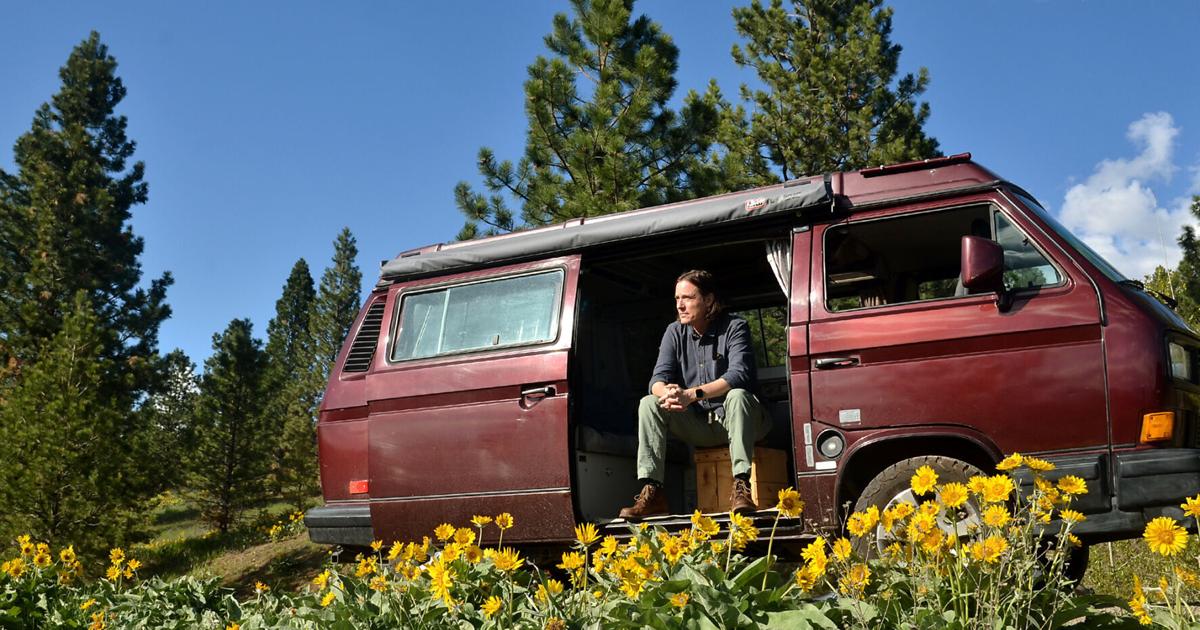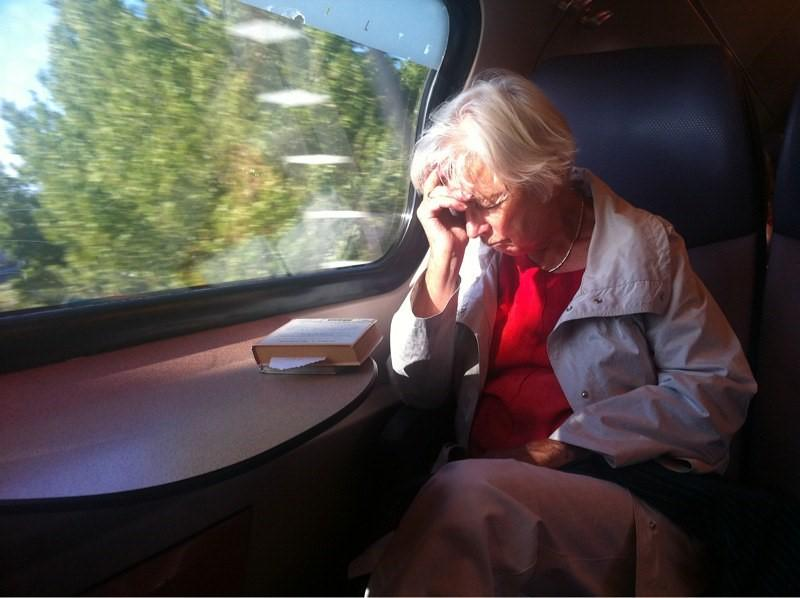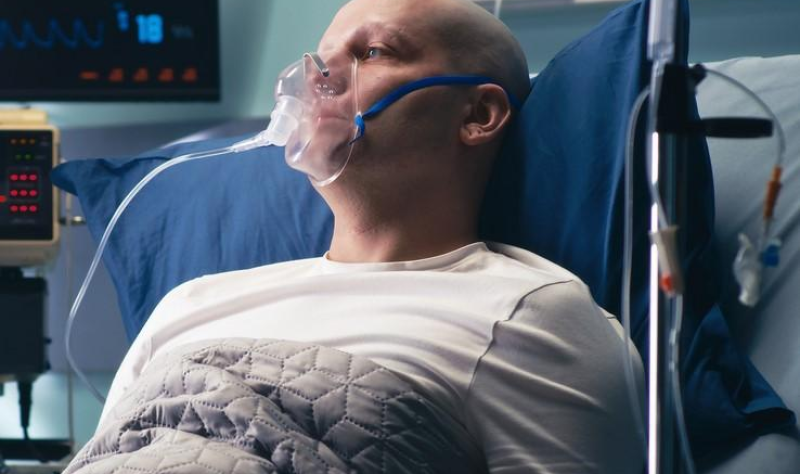Missed risk: Long COVID threat extends far beyond pandemic

Aaron Teasdale used to climb 6,000-meter peaks. Long COVID has made getting out of bed feel harder.
Since the poorly understood second act of the COVID-19 pandemic struck him last February, the Missoula-based adventurer and travel writer’s forays outdoors rarely get farther than the Mount Jumbo Saddle trailhead, where he parks his van and sits with the view. Many days, he doesn’t have the stamina or concentration to make the drive. Bikers and hikers pass behind him, and a meadow of arrowleaf balsamroot ripples across the hillside. Snow-dusted Bitterroot Mountains cap the view.
“When I look up at Lolo Peak and the sub-peak in front of it, I can see dozens of lines I’ve skied,” said Teasdale, 50. “I can look down the Bitterroots and see Mount Sweeney and St. Mary Peak and all those peaks and ridges I’ve skied — from right here, with the naked eye.”
While recovery from ME/CFS appears unlikely with current medical treatments, Teasdale does small things to stay positive, like wearing smiley-face socks.
April 2022 dropped some of the best spring snow backcountry skiers had ever seen. On the day of this interview, a friend asked to borrow Teasdale’s avalanche beacon for a run on Lolo Peak. He could barely walk down the driveway to hand it over.
People are also reading…
“At least I can park in places like this and look out over the world and look at the blooming balsamroot and listen to the returning birds and it’s beautiful,” Teasdale said. “I love being able to look at the mountains. Sometimes it’s hard, because they’re a reminder of who I used to be and what I used to do.”
What Teasdale used to do earned him 11 Lowell Thomas journalism awards for adventure travel, environmental travel and investigative reporting. Much of that involved exploring places at serious personal risk – both the North Pole and South Pole were on this spring’s itinerary for a book about extreme endurance trekking. When the COVID pandemic got rolling two years ago, he approached the disease the same way, rigorously following national guidance on how to avoid and prevent infection.
The message focused on how to keep people from dying, and how to keep hospital systems from crashing. And the answers were getting vaccinated and using social controls like quarantines and masking to curb the spread of the virus.
When he has the energy, Teasdale has kept extensive journals of his long-COVID symptoms, research and experiences.
But what if the big risk wasn’t death or system collapse, but debilitating illness? Last week, the United States logged its millionth dead COVID victim. In the same two years of this pandemic, 8 million people have contracted long COVID and become shadows of their former selves. According to the World Health Organization, one of every five of the 500 million COVID sufferers may develop long COVID.
That’s got Teasdale and many others wondering if our COVID response made a major error. For someone with a career based on doing risky things, that might sound contradictory. What’s the risk-management difference between a 1-in-10 chance of catching a bad disease and a 1-in-10 chance of catastrophic injury skiing Lolo Peak solo?
“That’s like setting up to ski a line on Lolo Peak, and I’ve checked my boots and made sure my skis are sharp and my bindings work — but nobody told me about avalanche danger,” Teasdale said. “My risk calculation was incomplete, and it missed the biggest potential threat.”
‘Everything since that day has been illness’
In April, Teasdale warned his friends in a social media post that he suffered from long COVID. Still, seeing him slowly walk down a sidewalk, dark glasses shielding his eyes — he looked two-dimensional, like a paper drawing of himself.
“Holiday travel got me,” Teasdale said. “On the spectrum of pandemic preparedness, I was 110% careful through the whole thing, much to the annoyance of many people.”
Teasdale had an emergency-room doctor friend who’d gone through hell in the last couple years dealing with hospital COVID cases. Yet last Christmas, that friend was telling Teasdale to relax — the threat had passed.
His family started debating a holiday get-together. They’d been separated two years. Some members still refused to get vaccinated. Omicron variant infections were rising.
But the news kept repeating that omicron was milder than previous variants, and the vaccination should provide adequate protection.
Outdoors writer Aaron Teasdale has found himself limited to watching the world from the back seat of his van, as he searches for a treatment for long-COVID’s chronic fatigue symptoms.
“We decided to mitigate the risks,” he said. “We were vaxxed and boosted at the start of December. We should have been at peak boost. We tested before we traveled. We got a sleeper car from West Glacier so we wouldn’t be around other passengers. A couple evangelical relatives wouldn’t even test, and we told them they couldn’t come. These were aunts and uncles who’d gathered together since I was a baby — and we said no, you can’t go. We were all afraid of bringing COVID to one of the grandparents.”
Then on the way back, there was a glitch with a ticket. He had them on his phone, and the app didn’t work. It was 10 p.m. in downtown St. Paul, his son and wife were already on board and he was getting upset. The conductor said he’d get it sorted out and asked Teasdale to wait in a room on the car with four other train employees.
The men all wore masks, but had them slipped down below their noses. Teasdale was together with them in a small room for 20 minutes.
“They were jovial and friendly and clearly meant well,” Teasdale said. “And they clearly gave me COVID.”
“I almost didn’t get on the train. I was wondering about making a stink about not wearing masks. In the first year, I would have taken that stand. I was that guy on airplanes, who’d tell other people to pull their masks up. But it had been two years. Everyone was relaxing. We’re in the clear. I let my guard down that one time in the train room. That’s my only possible exposure.”
Symptoms started showing up 72 hours later — the exact incubation period for omicron. It started with a tickle in the throat on New Year’s Day.
“My wife and I went skiing,” Teasdale said. “When there’s snow, I ski almost every day until July. We went up Spring Gulch from my house. It’s about a 7.5-mile ski. On the last mile I was dragging. I felt my throat more.”
Teasdale took a rapid home test, which read negative. So did the next day’s. He assumed he’d picked up a case of strep throat. Then he saw an article about home tests frequently failing to detect omicron infections.
“You have that moment of — Oh shit, I got it,” he said. “Two years and it finally got me.”
The day-5 test came back positive. He was sick for two weeks, with a headache, fever, night sweats and a violently sore throat. Around the third week of January, his symptoms seemed to let up. He started taking half-mile walks. Then one day he pulled on his cross-country boots and went for a ski.
“It was just two flat miles,” Teasdale said. “I had to stop frequently to catch my breath, leaning on the poles. But there were these bursts of wonderful feeling as I was gliding on skis.
“Then I got home and took my boots off and collapsed on a couch by the door. I was just crushed. That was the shortest ski I’ve done in decades, on Saturday the 21st. Everything since that day has been illness.”
Teasdale expected to pull out of his sickness, not plunge deeper. But in February his condition got scary.
An Apple watch rigged to monitor heart and blood-oxygen helps Teasdale stay within his energy limits. Even an emphatic thought in a conversation can trigger an alarm for his heart rate due to ME/CFS.
“I tried to walk from the house to the foot of the driveway and realized I didn’t know if I could make it back to the house,” he said. “It took a long time to walk that 60 feet.”
He got an Apple watch to monitor his heart rate and blood-oxygen levels. A healthy person’s oxygen level hangs between 100 and 95, and a heartbeat around 50 or 60 beats per minute. An athletic person like Teasdale may have a resting heart rate of 38.
On one of those driveway walks, a neighbor noticed him looking particularly stressed. Teasdale’s watch said his heart was pounding 130 beats a minute, and his blood-oxygen was at 77.
Beyond that, the world got oppressive. He needed noise-canceling headphones because whispers sounded ragged and painful. Even in bed, he wore eyeshades and darkened the room to lower the stress. His wife put felt bumpers on all the cabinet doors and drawers, because the thunk of their closing hurt.
“I had no context for those feelings,” Teasdale said. “Was it pain in the technical sense? My nervous system reacted like it was being physically struck by sounds. I couldn’t look at my phone. It was like it was vibrating aggressively — Oh God, put it away.
“My wife wondered every day if this was the day to bring me to the emergency room. Even my ER doctor friend in New Mexico was telling me it might be time to go. But I was so sensitive that the idea of getting into a car and going to a bright ER room was my worst nightmare. I knew it would hurt to do that. And I also knew they had no answers in the ER.”
Millions of Americans
Teasdale’s post-COVID symptoms match a condition called myalgic encephalomyelitis/chronic fatigue syndrome, or ME/CFS. It typically afflicts people recovering from a viral infection like SARS, Epstein-Barr or West Nile disease. While it’s considered neurological, it seems to invade the body from every portal: causing brain fog, sensitivity to light and sound, but also racing hearts, dropping oxygen levels, muscular aches, coordination issues — Teasdale simply feels like his body is going haywire.
In January, the journal Infection Control Today compiled other research forecasting more than 8 million Americans would develop long COVID. That’s at least three times the number of people currently diagnosed with ME/CFS (pre-COVID). The journal quoted #MEACTION editor Adriane Tilman feeling unsurprised.
“Long COVID is not a new phenomenon — there are millions of Americans who got sick with a virus and never recovered before the pandemic, and developed ME/CFS,” Tilman told ICT. “The only difference is that we are seeing this happen now in real time on a massive scale.”
That scale may envelop the ME/CFS community itself. In the same article, National Institute of Neurological Disorders and Stroke Director Walter Koroshetz said that in the past cases of ME/CFS developed out of a post-infectious illness: “(The) only difference here is that we know what virus is driving it in large numbers of persons.”
Playing guitar helps pass the time as Teasdale searches for a way past the fatigue of long COVID. The career writer had to cancel reporting trips to both the North and South poles this spring due to effects of the illness.
The ME/CFS community started raising alarms about the potential for chronic fatigue after-effects in May 2020 — two months after pandemic lockdowns started in the United States. They already had decades of research linking viral infections with the secondary health impacts.
“Coronavirus leading to more cases of ME will happen for sure, unfortunately,” Dr. Alain Moreau of Université de Montréal wrote in the 2020 advisory. “We need to be ready for the next wave.”
Vaccines have proved effective at preventing deaths and extreme immediate complications from COVID infections. But a recent study by the federal Veteran’s Administration looked at more than 30,000 COVID victims and found a neutral response for long COVID — the chance someone would get long COVID was even whether they had the vaccine or not.
And for an inanimate disease, it seems to have a vindictive personality. Most ME/CFS sufferers will start feeling better, take a longer daily walk or talk to a few more friends, and 24 hours later get flattened so hard they can’t lift a fork of dinner to their mouths. The process has a name: post-exertional malaise or PEM. Teasdale can feel it coming on after an interview runs over 90 minutes. His wife says he “looks PEM-y.”
PEM reactions worry Teasdale most when he hears about others trying to shake off long COVID. The temptation to get your life back, to apply positive thinking and goal-setting, often on doctors’ advice, results in a viral bait-and-switch, like accidentally throwing a bucket of gas on a fire when you thought you grabbed water.
That feeling of your body perking up like a cell phone with 1% left on its battery — flaring to life then fading to black before anything can get done — has rearranged Teasdale’s relationship with hope.
“We don’t traffic in hope here,” Teasdale said. “Because hope hurts. Hope is actually the thing that causes me the most pain, when it doesn’t work out. So you know, I can have all the positive thoughts in the world I want. But the reality is there’s something going on inside my body. Whether it’s something with my mitochondria, whether it’s vestiges of the virus in my organs, or brain, we don’t know. But it’s neurological. It’s cardiovascular. It’s pulmonary. And positive thinking doesn’t change that.”
For people with post-viral ME/CFS, the recovery rate after six months is about 5%. No cures exist yet. Some people have found occasional relief with mild stimulants like Ritalin, usually at much lower doses than prescribed for attention-deficit disorder. Diets designed to reduce inflammation also offer some help.
For many sufferers, that means a lifetime of long-term disability. Long COVID doesn’t qualify for workers compensation coverage.
The door of Aaron Teasdale’s van has become his only access to the outdoors after long COVID burdened him with secondary symptoms of myalgic encephalomyelitis/chronic fatigue syndrome. The energy-sapping condition has left the career outdoor writer mostly homebound.
Will to live
A few years ago, Teasdale climbed Huayna Potosi, a 19,974-foot peak in Bolivia. Anyone who’s tried trekking above 10,000 feet knows the confounding exhaustion of exerting at altitude. The body feels leaden. The head hurts and can’t think straight. Yet some third part of a dedicated climber, some soul or will to live, keeps pushing one foot in front of the other until you’re straddling a knife-edge summit, legs dangling off either side, barely noticing the sense of accomplishment or joy that will only crystalize days later, in contrast to everyday existence.
Teasdale’s adventure writing took him to the summit of Huayna Potosi, a 19,974-foot peak in Bolivia. This spring, he won a 2021 “Best Adventure Story” award from the North American Travel Journalists Association. Long COVID has made it almost impossible to walk to the end of his driveway now.
“As long as I’m alive, I’ve got to get better,” Teasdale said. “I’ve got to get myself back. I am going to do that. Positivity, to me, means I’m positive I’m going to do everything I can to heal. And I’m positive I’m going to live as well as I can and contribute as much as I can to the world with whatever energy is available to me. I’m positive of that.
“But I’m not positive that I’m going to heal. Because most people with this illness don’t heal. And that’s the sad truth.”
#lee-rev-content { margin:0 -5px; } #lee-rev-content h3 { font-family: inherit!important; font-weight: 700!important; border-left: 8px solid var(–lee-blox-link-color); text-indent: 7px; font-size: 24px!important; line-height: 24px; } #lee-rev-content .rc-provider { font-family: inherit!important; } #lee-rev-content h4 { line-height: 24px!important; font-family: “serif-ds”,Times,”Times New Roman”,serif!important; margin-top: 10px!important; } @media (max-width: 991px) { #lee-rev-content h3 { font-size: 18px!important; line-height: 18px; } } #pu-email-form-daily-email-article { clear: both; background-color: #fff; color: #222; background-position: bottom; background-repeat: no-repeat; padding: 15px 0 20px; margin-bottom: 40px; border-top: 4px solid rgba(0,0,0,.8); border-bottom: 1px solid rgba(0,0,0,.2); display: none; } #pu-email-form-daily-email-article, #pu-email-form-daily-email-article p { font-family: -apple-system, BlinkMacSystemFont, “Segoe UI”, Helvetica, Arial, sans-serif, “Apple Color Emoji”, “Segoe UI Emoji”, “Segoe UI Symbol”; } #pu-email-form-daily-email-article h1 { font-size: 24px; margin: 15px 0 5px 0; font-family: “serif-ds”, Times, “Times New Roman”, serif; } #pu-email-form-daily-email-article .lead { margin-bottom: 5px; } #pu-email-form-daily-email-article .email-desc { font-size: 16px; line-height: 20px; margin-bottom: 5px; opacity: 0.7; } #pu-email-form-daily-email-article form { padding: 10px 30px 5px 30px; } #pu-email-form-daily-email-article .disclaimer { opacity: 0.5; margin-bottom: 0; line-height: 100%; } #pu-email-form-daily-email-article .disclaimer a { color: #222; text-decoration: underline; } #pu-email-form-daily-email-article .email-hammer { border-bottom: 3px solid #222; opacity: .5; display: inline-block; padding: 0 10px 5px 10px; margin-bottom: -5px; font-size: 16px; } @media (max-width: 991px) { #pu-email-form-daily-email-article form { padding: 10px 0 5px 0; } }



